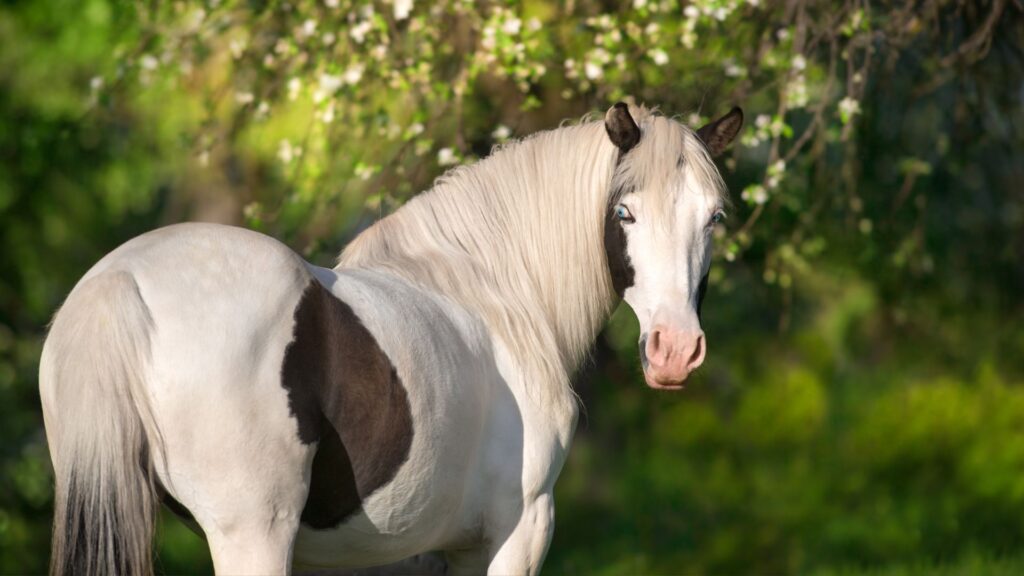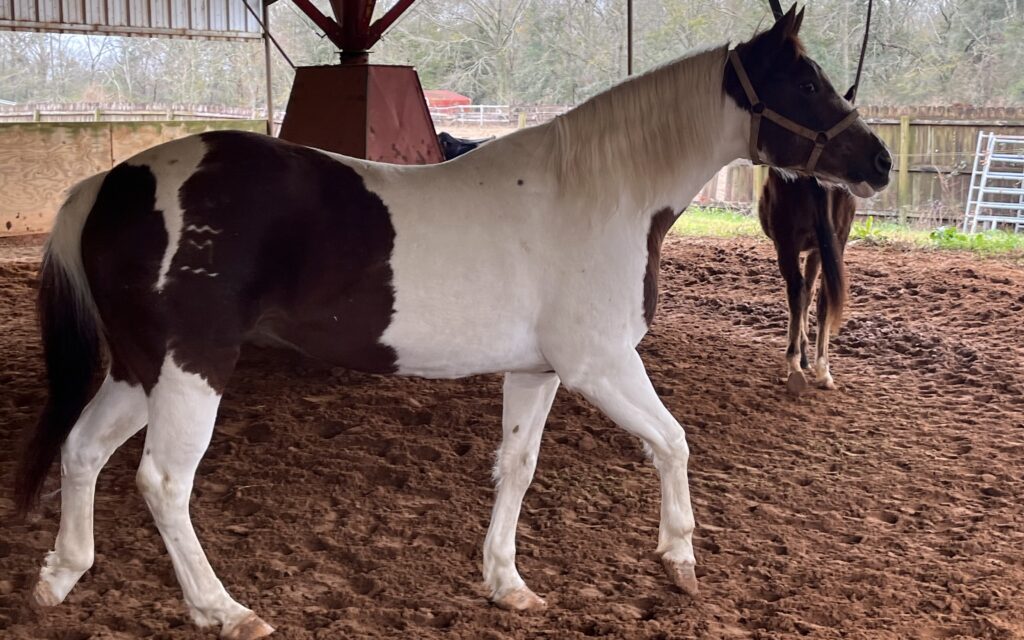Published on: July 17, 2023
As I wandered through a horse show, my attention was captivated by a remarkable sight. A horse adorned in a coat resembling a beautiful patchwork quilt stood out among the crowd. Intrigued, I asked, “What kind of horse is that?” This led me on a journey of discovery into the world of piebald horses.
Piebald horses are a type of horse known for their distinct black and white coat patterns. These patterns result from a unique genetic trait that influences how pigmentation is distributed across their bodies. Their characteristic appearance sets them apart from other horses, making them truly fascinating and easily identifiable.
In this article, we’ll explore the fascinating world of piebald horses. We’ll dive into the science behind their vibrant colors and distinctive patterns. Get ready for a thrilling journey, uncovering the beauty and allure of these extraordinary animals.

What are Piebald Horses?
Piebald horses are a wonder to behold. These extraordinary horses are like living, breathing works of art. Their coats are a stunning mix of black and white, unlike many other horses that sport just one color.
What’s even more incredible is that each piebald horse is entirely unique – you won’t find two with the same pattern of black and white. It’s like they each have their own special code of colors. But how do piebald horses get those amazing black-and-white patterns?
The Intriguing Black and White Patterns
The black and white patterns are formed by their genes, the tiny bits of information in their bodies that decide what color their coats will be. In Piebald horses, these genes create patches of black and white all over their bodies.
The black patches show where there’s color, and the white patches show where there’s no color at all. It’s like a natural masterpiece painted on each horse, giving them their unique and eye-catching looks.
The Science Behind the Color: Piebald Horse Genetics
Have you ever wondered how Piebald Horses get their unique black-and-white patterns? Let’s dive into the fascinating world of genetics and explore the DNA blueprint that paints each Piebald Horse in its one-of-a-kind design.
The Paintbrush of Genetics
Piebald coloration in horses is not caused by a single “Piebald gene,” but rather by a combination of genes responsible for different white spotting patterns over a black base coat. The term “Piebald” broadly describes horses that have black and white coat patterns, and these patterns can be attributed to various genes, including Tobiano, Sabino, Splash, and Frame (Overo), as you correctly pointed out.
Tobiano, for example, often creates large, rounded, white patches across the back of the horse, between its ears and tail. The Sabino pattern, on the other hand, typically results in irregular, lacy, or roaning edges of white markings.
The splash gene causes white markings that make the horse appear as though it’s been dipped in white paint, often including blue eyes. The Frame pattern, also known as Overo, creates a frame of color around white patches, leaving the horse’s back colored.
Each of these genes can influence the overall appearance of a Piebald horse, and they can appear in combination, leading to a broad variety of unique and striking patterns. It’s an intricate and fascinating aspect of equine genetics.

Inheriting the Piebald Pattern
But the story doesn’t end there. How does a horse get the Piebald gene in the first place? The answer lies in the family tree. Just like you inherit your eye color from your parents, a horse gets the Piebald gene from its mom or dad.
This is why if you have a Piebald Horse, there’s a good chance its parents, or even its grandparents, had stunning black and white patterns. However, the pattern can change from one generation to the next, creating a beautiful and endless variety of designs. So, every Piebald Horse tells its own unique, colorful story.
Horse Breeds Known for Piebald Patterns
Piebald patterns aren’t limited to just one breed of horse; you can find these distinctive black and white coats in many different breeds. Some breeds that are known for often having piebald individuals include the American Paint Horse, the Gypsy Vanner, and the Shetland Pony. Each of these breeds brings its own charm to the piebald pattern, showing off the striking contrast in its unique way.
Spotlight on Specific Breeds
Let’s look at a couple of these breeds in more detail. American Paint Horses are well-loved for their color patterns, which include piebald. These horses are not only beautiful; they’re also known for their friendly nature and versatility in various equestrian activities.
Gypsy Vanners, originally bred by the Romani people of Britain, often sport piebald coats. These horses are admired for their strength, gentle temperament, and, of course, their stunning appearance.
Finally, Shetland Ponies, though small in size, can proudly display piebald patterns too. Despite their petite stature, these ponies are incredibly strong and hardy, making them much more than just their beautiful coats.

Piebald vs. Skewbald: Spotting the Differences
When it comes to the wonderful world of horse coat colors and patterns, two terms you might hear are “Piebald” and “Skewbald.” Both refer to a kind of coloration that features large patches of white, but they’re not quite the same. So, what distinguishes a Piebald Horse from a Skewbald one? Let’s dive in and uncover the differences between these two captivating equine color patterns.
Understanding Piebald Horses
As we’ve learned, a Piebald Horse is black and white. But where does the word “Piebald” come from? It’s a combination of “pie,” from “magpie” (a bird known for its black and white plumage), and “bald,” an old term meaning “white patch” or “blaze,” especially on a horse’s face. So, a Piebald Horse is essentially one that’s black and white, like a magpie.
Defining Skewbald Horses
On the other hand, a Skewbald Horse has a coat consisting of white and any color other than black, often brown or chestnut. The term “Skewbald” comes from “skew,” meaning “askew” or “off-center,” and “bald.” It’s thought this might refer to how the patches of color appear scattered or off-center on the horse’s coat.
Piebald vs. Skewbald: The Differences
So, the primary difference between a Piebald and a Skewbald Horse lies in their colors. Remember, a Piebald is black and white, like a magpie bird, while a Skewbald is white and any color other than black. It’s all about the unique combination of colors each horse wears in its coat. But whether a horse is Piebald or Skewbald, both sport a distinctive, vibrant pattern that makes them stand out in any herd.

Caring for a Piebald Horse
When it comes to care, Piebald Horses are just like any other horse, needing the same level of attention and upkeep. However, their light-colored patches can sometimes be more susceptible to sunburn. So, if you’re the proud owner of a Piebald Horse, consider applying equine sunscreen to the white parts of their face or coat and provide a shady retreat during the sunniest parts of the day.
General Horse Care and Maintenance Tips
Taking care of a horse, whether it’s a Piebald or not, requires time, commitment, and knowledge. Here are a few tips:
- Balanced Diet: Just like us, horses need a balanced diet to stay healthy. This usually includes good-quality hay, grains, fresh fruits and vegetables, and plenty of fresh water.
- Regular Exercise: Horses need regular exercise to keep their bodies strong and their minds sharp. The type and amount of exercise depend on the horse’s age, health, and job.
- Health Check-ups: Regular vet check-ups are essential for the early detection of any health issues. It’s also vital to keep up with their vaccinations and deworming treatments.
- Grooming: Regular grooming not only keeps your horse’s coat looking nice, but it also allows you to check for any skin problems, like cuts or ticks. Plus, it’s a great way to bond with your horse!
Remember, each horse is unique and may have specific needs. Always consult with a vet or an experienced horse person if you have any questions. Taking care of a Piebald Horse, or any horse, is a big responsibility, but the reward is a loyal and loving companion.
Conclusion
Throughout this journey, we’ve discovered the captivating world of Piebald Horses. From their mesmerizing black and white coat patterns that resemble a patchwork quilt to the fascinating genetics behind these unique designs, there’s no denying that Piebald Horses are truly special creatures.
We’ve also discovered that their distinct coloring doesn’t limit them to a specific breed; instead, their charm enhances a wide range of horse breeds, from American Paint Horses to Shetland Ponies.
Piebald Horses are undeniably striking. Their bold color contrasts and distinct patterns make them stand out in any crowd, while their individual personalities make them beloved companions. Whether you’re an avid horse lover, an aspiring equestrian, or someone who simply appreciates natural beauty, the allure of Piebald Horses is undeniable.
FAQs
What is the difference between a piebald horse and a paint horse?
A Piebald Horse has a coat of black and white patches. A Paint Horse, on the other hand, is a breed known for pinto patterning, which includes large areas of white and any other color, including black. So, a Paint Horse could potentially be piebald if it has black and white coloring.
What is the difference between Appaloosa and piebald horses?
An Appaloosa is a distinct horse breed known for its spotted coat, striped hooves, and other unique traits. On the other hand, Piebald is not a breed but a coat color pattern characterized by black and white patches. Any breed of horse can exhibit this pattern, including Appaloosas.

About the Author: Miles Henry
Lifelong Horseman | Racehorse Owner | Published Author
Miles Henry brings over 25 years of hands-on experience training and owning Thoroughbred racehorses. Raised with Quarter Horses and Appaloosas, he’s spent a lifetime learning from horses—on the track, in the barn, and in the field. Today, he runs a small but successful racing stable in Louisiana and shares real-world insights on HorseRacingSense.com, helping horse owners, fans, and bettors navigate the sport with confidence.
📚 Books: View Miles’s books on Amazon »
🎧 Podcast Guest: Animal Tales Ep. 32 |
YouTube Interview
📩 Newsletter: Sign up for racing tips and horse care advice »
🔗 Follow Miles:
Twitter |
Facebook |
YouTube

